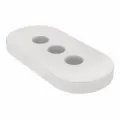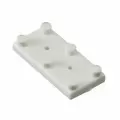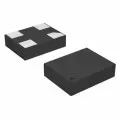OUTLINE:
Something You Need to Learn about Electrical Socket Outlet Symbol
 212
212Understanding the symbols on the socket is so important for people who frequently come into contact with electricity!
These symbols are like the "ID card" of an electrical outlet, telling you what type it is, how much voltage it has, and whether it is safe or not.

Image Source:Vecteezy.com
In this way, you can avoid danger and ensure that you dress up correctly.
Whether you are a professional electrician or a friend who likes to do it yourself, understanding these symbols can give you a clear idea and make your work safer.
Next, let's talk about these important socket symbols, see what they really say, and how they help our electrical system become safer and more user-friendly.
What Is An Electrical Socket Outlet (Quick Answer)
Power sockets are the common small things on the walls of our homes that are convenient for us to connect electricity. Look, the phone is almost out of battery.
With a snap, insert it into the small hole on the wall. Hey, the power is coming, and the phone can be resurrected with full health again.
Not only mobile phones, but also electric fans, televisions, refrigerators, these big things need to rely on them to get moving.
We call it a "socket" or "power jack", which is very friendly and grounded. With it, using household appliances is a convenience, and you can enjoy the convenience brought by electricity anytime, anywhere.
What Are the Two Types of Socket Wire (With Recommended Sockets)
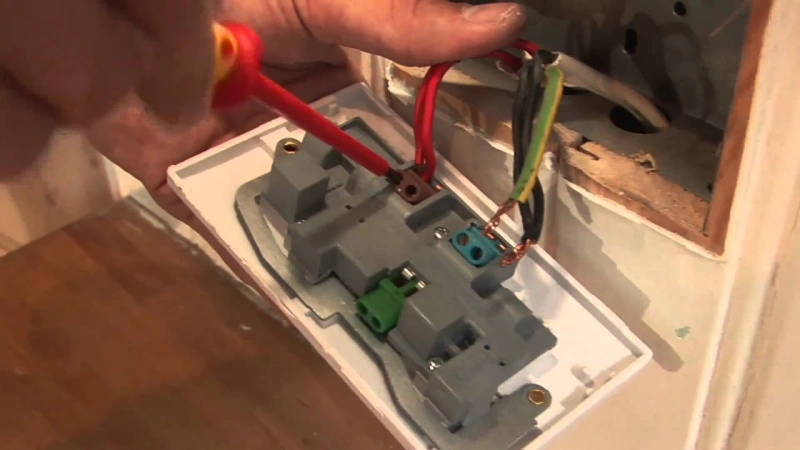
Image Source:Youtube
When it comes to the wiring of sockets, there are mainly two types, one is single-phase and the other is three-phase. These two types have their own uses and come with different socket designs.
Let's start with single-phase lines, which are the most commonly used in homes and small buildings. It usually has two wires, one is the live wire, the other is the neutral wire, and sometimes a ground wire is added for greater safety. This type of circuit supplies power to our household appliances, such as lights, refrigerators, televisions, etc. The voltage varies from 120 volts to 240 volts depending on the location.
Single phase sockets, such as the A and B types in North America, are standard 120V sockets with and without grounding wires. The C and F types are also quite common in Europe, mainly used for single-phase electricity of 230 volts. The G-type socket in the UK is also 240 volts, with a safety door and grounding hole, which is quite safe.
Let's talk about three-phase power lines, which are mainly used in factories, shopping malls, and other places that require high-power electricity. It has three live wires and one neutral wire, with particularly high power transmission efficiency. This system has a stable power supply and is suitable for large machines, heavy-duty motors, and commercial equipment.
Three phase sockets, like the international standard IEC 60309, are particularly durable and safe, and the colors are also classified according to voltage levels, which can be seen at a glance. Italian L-shaped sockets also have three-phase, and 16 ampere ones are quite common. The NEMA L21-30 in North America is also three-phase, with a voltage of 208 volts, and is commonly used in industrial applications.
To sum up, single-phase sockets are suitable for home use, while three-phase sockets are good helpers for industrial and commercial occasions.
And Speaking of electrical sockets, let me talk about a few practical ones:
Leviton T5320-W, The standard household socket and the design to prevent children from moving around are perfect for home use.
Legrand Radiant 885TRW, his waterproof socket is definitely suitable for outdoor installation, it is not afraid of wind and rain.
TP-Link Kasa Smart Plug, The smart socket is here! With a little Wi Fi on your phone, you can easily turn on and off electrical appliances, which is very convenient.
Eaton TR7740W-1, This one is even better, with a socket and USB interface, you no longer have to worry about charging your phone or tablet.
Let's talk about the "sockets" on the internet, which are software level:
TCP/IP Sockets, The bridge for communication between the client and server, loved by websites and databases.
UNIX Domain Socket, A secret channel between different programs on the same computer, commonly used in operating systems.
WebSocket, On a single TCP line, two-way chat is seamless, and real-time web applications love it the most.
Common Symbols of An Electrical Socket Outlet
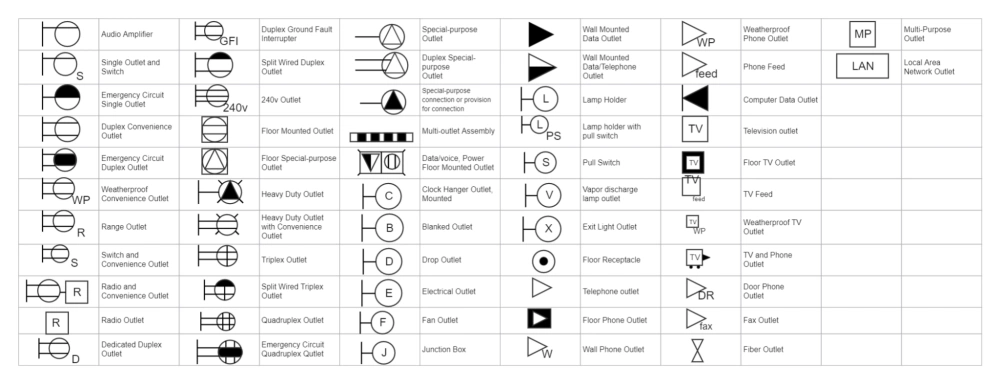
Image Source:EdrawMax
When it comes to the common symbols of electrical sockets, they are like the "ID card" of the socket, each with its own purpose. Let's talk about some common ones:
A small grounding symbol (sometimes lightning plus three wires) indicates that the socket has grounding protection and is safer to use electricity.
The voltage number (such as 120 or 220) tells you how much electricity the socket can withstand, so don't overload it.
The current number (such as 15 or 20) is the maximum current that the socket can pass. The electrical appliance should not be too large, otherwise the socket will "exhaust".
The CE small mark indicates that the socket complies with European safety standards and has guaranteed quality.
UL certification, commonly seen in North America, is like a "safety certificate" for sockets, allowing people to use it with confidence.
The IP rating (such as IP44 or IP65) is the "waterproof and dustproof rating" of the socket. The larger the number, the less afraid of water and dust.
A small symbol (TR) to prevent children from randomly inserting, especially for those with children at home, this design can protect them from being electrified.
USB small symbol, if there is this on the socket, it means it has a USB interface, making charging super convenient.
The small button of GFCI is usually located at the edge of the sink or on the socket in the bathroom. In case of leakage, pressing it can restart the socket, which is safe and practical.
How to Identify Symbols of An Electrical Socket Outlet
Take a closer look at the socket:
Surface inspection: First, check if there are any symbols or text printed on the socket panel, such as voltage, current, and any certification marks.
Take a look around the socket hole: Sometimes symbols are also engraved or printed there.
Take a look at the USB port: If the socket has a USB port, you also need to check for symbols related to USB specifications or charging capabilities.
Check the product manual:
Search for manual: Check if there is an instruction manual in the packaging, or look for the electronic version on the manufacturer's website.
Explanation of Symbols: There is usually a section in the manual that explains symbols in detail, explaining the meaning of each symbol.
Look at the data sheet: If there is a product data sheet or technical specification book, it will definitely list and explain the symbols on the socket.
Search online:
Manufacturer's website: Search for your socket model on the manufacturer's website and see if there are any symbols in the product introduction or technical details.
Check standards: Check industry standards or technical guidelines related to sockets, which often have symbol explanations.
Ask a professional:
Find an electrician: If you don't understand or want to confirm, then find a certified electrician to help you check.
Let the electrician explain: An electrician can not only help you recognize the symbols on the socket, but also tell you how important these symbols are for safe use and correct operation.
What Is the Electrical Socket Outlet Symbol Used for
Let's talk about what those symbols on the socket do, they can tell us a lot of information about the socket!
Grounding symbol (⏚): This indicates that the socket has a grounding function, which can prevent electric shock and ensure electrical safety.
Voltage level (such as 120V, 220V): tells us the maximum voltage that the socket can withstand, ensuring that the appliances we plug in will not break or be in danger due to incorrect voltage.
Current level (such as 15A, 20A): Refers to the maximum current that the socket can withstand, preventing overheating or fire, and protecting our home.
CE mark: This indicates that the socket complies with European safety, health, and environmental standards, and is a "certificate of conformity" on the EU side.
UL certification: This is a safety certification from North America, indicating that the socket has passed testing and is very safe to use.
IP rating (such as IP44, IP65): This refers to the dustproof and waterproof rating of the socket. The larger the number, the better the protection, making it suitable for outdoor or humid places.
Anti misoperation symbol (TR): A socket with this symbol can prevent children from inserting things randomly, making it safer.
USB symbol: indicates that there is a USB interface on the socket, which can directly charge devices such as mobile phones and tablets, making it extremely convenient.
GFCI test/reset button: This is used on sockets with GFCI function, which can detect whether the socket is working properly. If leakage is detected, the power will be cut off to protect us from being electrified. It is particularly suitable for use in places with high water such as kitchens and bathrooms
The End
Understanding electrical socket outlet symbols is crucial for safe and effective usage. These symbols provide essential information on voltage, current ratings, safety features, and environmental suitability. By recognizing and interpreting these symbols, you can ensure proper compatibility, enhance safety, meet regulatory standards, and make the most of additional features like USB ports. This knowledge helps maintain a safe and efficient electrical environment.

Disclaimer: The views and opinions expressed by individual authors or forum participants on this website do not represent the views and opinions of Chipsmall, nor do they represent Chipsmall's official policy.

share this blog to:


